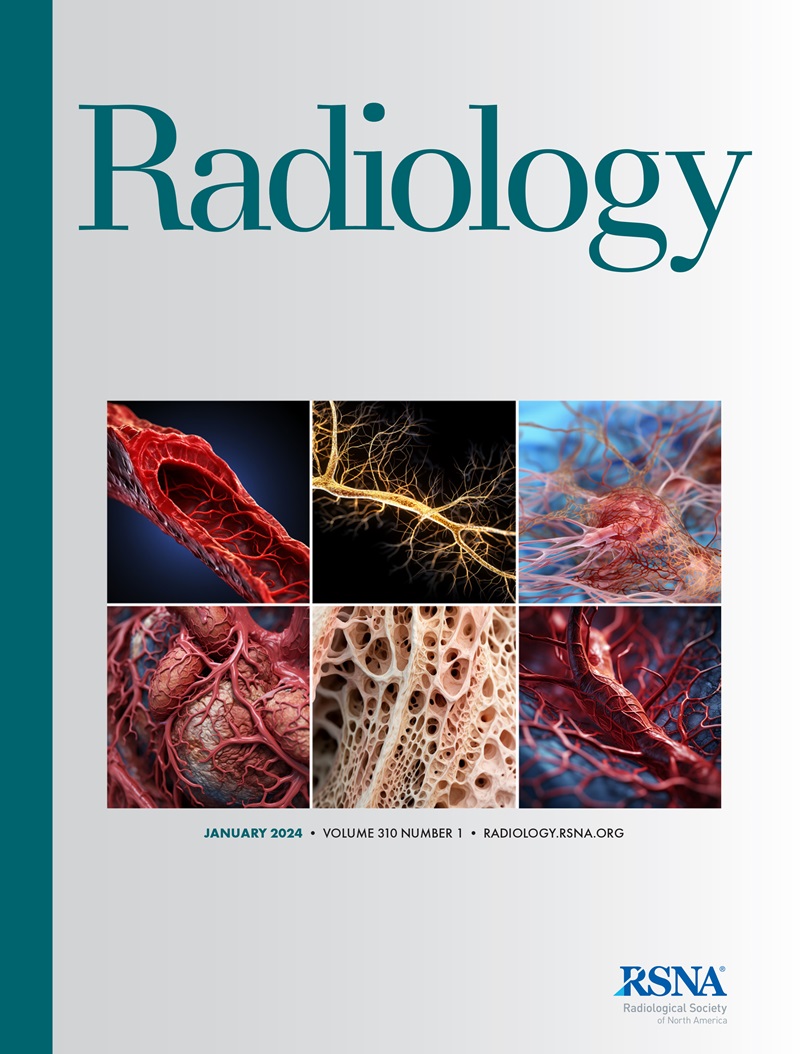18F-FDG PET/CT of Oligometastatic Disease in Locally Advanced Breast Cancer: PETABC Trial Post Hoc Analysis.
IF 15.2
1区 医学
Q1 RADIOLOGY, NUCLEAR MEDICINE & MEDICAL IMAGING
引用次数: 0
Abstract
Background The optimal treatment of patients with oligometastatic breast cancer and the methods for selecting individuals who may benefit from metastasis-directed therapies are controversial. Purpose To determine the prevalence of oligometastatic disease (OMD; defined as five or fewer distant metastases) in patients with locally advanced breast cancer initially staged at fluorine 18 (18F) fluorodeoxyglucose (FDG) PET/CT or at CT and bone scintigraphy (CTBS), and to compare patterns of local-regional and distant metastatic disease. Materials and Methods This is a post hoc analysis of data from a prospective, multicenter randomized trial including participants with stage IIb (T3N0) or III invasive ductal carcinoma in the breast between December 2016 and April 2022. Participants were randomized for staging at 18F-FDG PET/CT or at conventional chest, abdomen, and pelvis CTBS. The prevalence of OMD, sites of distant metastases, and extent of local-regional disease were compared using the χ2 test or Fisher exact test. Logistic regression was used to assess the association between imaging and disease extent, with P < .05 indicating a statistically significant difference. Results The study included 369 participants (mean age, 53 years ± 13 [SD]). OMD was more common on 18F-FDG PET/CT scans (19 of 180; 11%; 95% CI: 6.9, 15.9) than on CTBS scans (eight of 185; 4%; 95% CI: 2.2, 8.3; P = .03). Polymetastatic disease (more than five distant metastases) was also more common on 18F-FDG PET/CT scans (24 of 180; 13%) than on CTBS scans (13 of 185; 7%; P = .04). Patients with OMD that was depicted on 18F-FDG PET/CT and CTBS scans had axillary lymph node metastases, but 18F-FDG PET/CT helped to detect extra-axillary regional lymphadenopathy, extra-regional lymph node metastases, and liver metastases more frequently than did CTBS (six of 19 [32%] vs one of eight [13%], three of 19 [16%] vs 0 of eight [0%], and six of 19 [32%] vs one of eight [13%], respectively; P = .63, .53, and .63, respectively). Conclusion At patient presentation, 18F-FDG PET/CT helped to detect OMD in more than one in 10 participants with locally advanced breast cancer, which was more than 2.5 times more often than CTBS, and 18F-FDG PET/CT helped to detect more extensive local-regional metastatic disease. ClinicalTrials.gov Identifier: NCT02751710 © RSNA, 2025 Supplemental material is available for this article. See also the editorial by Ulaner in this issue.18F-FDG PET/CT在局部晚期乳腺癌中的低转移性疾病:PETABC试验事后分析
背景低转移性乳腺癌患者的最佳治疗方法和选择可能受益于转移导向治疗的个体的方法存在争议。目的了解低转移性疾病(OMD)的患病率;在氟18 (18F)氟脱氧葡萄糖(FDG) PET/CT或CT和骨显像(CTBS)初始分期的局部晚期乳腺癌患者中,定义为5个或更少的远处转移),并比较局部-区域和远处转移疾病的模式。材料和方法这是一项前瞻性多中心随机试验的事后分析数据,该试验包括2016年12月至2022年4月期间患有IIb期(T3N0)或III期乳腺浸润性导管癌的参与者。参与者被随机分为18F-FDG PET/CT或传统的胸部、腹部和骨盆CTBS分期。采用χ2检验或Fisher精确检验比较OMD的患病率、远处转移部位和局部-区域病变程度。采用Logistic回归评估影像学与病变程度的相关性,P < 0.05为差异有统计学意义。结果共纳入369例受试者,平均年龄53岁±13岁[SD]。OMD在18F-FDG PET/CT扫描中更为常见(180例中有19例;11%;95% CI: 6.9, 15.9)比CTBS扫描(185例中有8例;4%;95% ci: 2.2, 8.3;P = .03)。多转移性疾病(超过5个远处转移)在18F-FDG PET/CT扫描中也更常见(180人中有24人;13%)比CTBS扫描(185例中有13例;7%;P = .04)。18F-FDG PET/CT和CTBS扫描显示的OMD患者有腋窝淋巴结转移,但18F-FDG PET/CT比CTBS更频繁地发现腋窝外区域淋巴结病变、区域外淋巴结转移和肝脏转移(19例中有6例[32%]对8例中有1例[13%],19例中有3例[16%]对8例中有0例[0%],19例中有6例[32%]对8例中有1例[13%];P分别= 0.63、0.53和0.63)。在患者出现时,18F-FDG PET/CT帮助发现超过十分之一的局部晚期乳腺癌患者的OMD,这是CTBS的2.5倍以上,并且18F-FDG PET/CT有助于发现更广泛的局部-区域转移性疾病。ClinicalTrials.gov标识符:NCT02751710©RSNA, 2025本文提供补充材料。另见乌兰纳在本期的社论。
本文章由计算机程序翻译,如有差异,请以英文原文为准。
求助全文
约1分钟内获得全文
求助全文
来源期刊

Radiology
医学-核医学
CiteScore
35.20
自引率
3.00%
发文量
596
审稿时长
3.6 months
期刊介绍:
Published regularly since 1923 by the Radiological Society of North America (RSNA), Radiology has long been recognized as the authoritative reference for the most current, clinically relevant and highest quality research in the field of radiology. Each month the journal publishes approximately 240 pages of peer-reviewed original research, authoritative reviews, well-balanced commentary on significant articles, and expert opinion on new techniques and technologies.
Radiology publishes cutting edge and impactful imaging research articles in radiology and medical imaging in order to help improve human health.
 求助内容:
求助内容: 应助结果提醒方式:
应助结果提醒方式:


